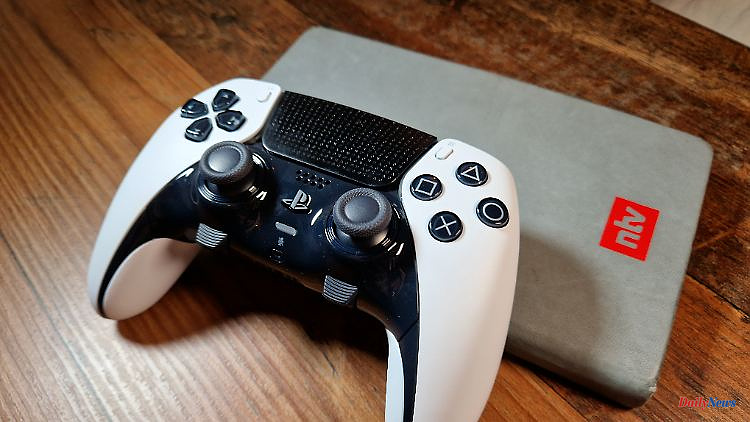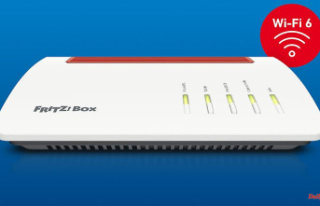Immerse yourself in the world of first-person shooters and action games - a pro controller can definitely help here. Sony is now launching a modifiable gamepad for the Playstation 5. ntv.de tested it.
It can also be a bit more: at least as far as buttons, functions and digital modifications are concerned. With the DualSense Edge, Sony is launching its first proprietary pro gaming controller for the Playstation 5. ntv.de was able to test the gamepad before the release. What can the DualSense Edge do and who is it worth it for?
Sony has not made any changes to the design, the manufacturer only uses more contrast in the paintwork. The touchpad, action buttons, directional cross and part of the fairing are now black. Overall, the device weighs 325 grams, around 45 grams heavier than the standard PS5 controller. The Edge even feels a little better in the hand as it offers more grip thanks to a rougher chassis surface.
Of course, the Edge also has the controller features that were highly praised when the PS5 went on sale, such as haptic feedback and adaptive trigger buttons. On the other hand, the Fn keys are new and immediately recognizable. The two plastic extensions protrude slightly below the two sticks. Its function is to quickly pop up a small options menu that can be used to control the volume and switch between previously created user profiles.
That sounds a bit disappointing at first, but leads to the strengths of the Edge. The controller can be adjusted mechanically and digitally, especially for first-person shooters. On the one hand, there are two controls on the back side of the L2/R2 buttons. The controls can be set to standard, medium and strong, thus shortening the trigger dead zone, i.e. the time from finger contact to the actual key input. That's a noticeable and useful improvement, after all, the two buttons are used for aiming and shooting.
The input path can be further refined digitally. A range from 0 to 100 regulates when the entry is made. The lower, the faster the trigger is pulled or aimed. The embroidery sensitivity can also be set digitally. The shooter "Call of Duty" was mainly played in the test. The digital standard settings of the two sticks looked much more sluggish in movement and aiming than with the normal PS5 controller. Only after selecting one of the stick sensitivity profiles did the shooter play more smoothly again, and everything seemed more agile.
"Fast", "Precise", "Constant", "Digital" and "Dynamic" - as the profile specifications are called - all have different reaction curves, which can be individually adjusted again. The explanations for the individual profiles already show which customers Sony wants to address: fans of action games and shooters should have advantages in particular. In the test, the combination of "Dynamic" (left stick) and "Fast" (right stick) left the greatest impression. This is where both left stick movement and right stick aiming felt the best.
But you have really big advantages through the individual key assignment. In addition, Sony has built in the option of attaching two paddle buttons to the back of the controller, which simply fit into the socket thanks to magnets. The back keys come in two shapes, wing and crescent, depending on which ergonomically fits the player's hand better. You can't assign individual gameplay commands to these keys, but their functions can.
If, for example, the X and O buttons are assigned to the paddle, the elementary commands "jump" and "slide" can be controlled by two fingers, which are otherwise not used at all - as long as the controller is held in a conventional manner. This keeps your thumb on the right aim stick. In a game like Call of Duty, once finger coordination has become second nature, that becomes a real advantage. The paddles allow you to aim and fire faster after the slide command. Even the popular "jump shot" (jump around the corner, aim, shoot and surprise your opponent) is easier to handle.
Of course, that all sounds very special and so the Edge is aimed more at heavy users when it comes to shooters. The proud price of 240 euros cannot be justified at all for occasional gamers. That's three times the price of a standard PS5 controller and more than half the price of a console.
The scope of delivery is decent for the price. A chic protective case made of hard plastic, six different round caps for the sticks, which can therefore be quickly exchanged, the paddles mentioned and a charging cable around two meters long including the connector housing. This is to prevent the cable from slipping off in the heat of the moment - the attachment even has a lock function with two hooks that fix the cable to the controller. The bad thing is that the fit is only designed for the supplied cable and other USB-C connections in the housing cannot be properly fixed.
And you can actually leave the Edge controller connected right away, because the battery performance is the same as that of the normal DualSense, but the demands on the Edge are higher. That goes on the battery. After around 7.5 hours, the Edge was drained in the test, the normal DualSense lasts up to ten hours.
A real top feature is the exchangeable embroidery module. Part of the front chassis can be opened with a release slider on the back. A small bracket levers out the module. This is how the biggest controller problem can be solved: Stick drift, i.e. the warping of the controllers without noticeable influence. It's a normal but annoying sign of wear and tear on gamepads. Sony offers a replacement module for 25 euros, which is a fair price to bring the controller back into shape yourself. But here, too, it's more profitable for heavy users whose controller consumption is well over 1 per year - and here, too, the purchase only pays off after three to four years.
In summary, one can say that Sony has succeeded in creating a very good pro controller with DualSense Edge, but the target group is rather small. Yes, the Edge can be an advantage in shooters, but of course it doesn't automatically make your gameplay better. Occasional gamers should be deterred by the high price anyway. If you count shooters as your gaming passion, you can use the Edge to improve your skills wonderfully.












